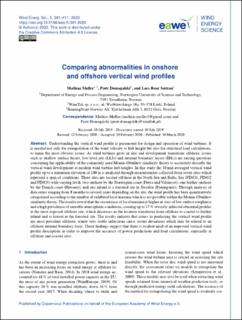| dc.contributor.author | Møller, Mathias | |
| dc.contributor.author | Domagalski, Piotr | |
| dc.contributor.author | Sætran, Lars Roar | |
| dc.date.accessioned | 2020-04-30T07:30:31Z | |
| dc.date.available | 2020-04-30T07:30:31Z | |
| dc.date.created | 2020-04-29T11:02:48Z | |
| dc.date.issued | 2020 | |
| dc.identifier.citation | Wind Energy Science. 2020, 5 391-411. | en_US |
| dc.identifier.issn | 2366-7443 | |
| dc.identifier.uri | https://hdl.handle.net/11250/2653001 | |
| dc.description.abstract | Understanding the vertical wind profile is paramount for design and operation of wind turbines. It is needed not only for extrapolation of the wind velocity to hub height but also for structural load calculations, to name the most obvious issues. As wind turbines grow in size and development transitions offshore, issues such as shallow surface layers, low-level jets (LLJs) and internal boundary layers (IBLs) are raising questions concerning the applicability of the commonly used Monin–Obukhov similarity theory to accurately describe the vertical wind development at modern wind turbine hub heights. In this study the 10 min averaged vertical wind profile up to a minimum elevation of 100 m is analyzed through measurements collected from seven sites which represent a span of conditions. Three sites are located offshore in the North Sea and Baltic Sea (FINO1, FINO2 and FINO3) with varying fetch, two onshore by the Norwegian coast (Frøya and Valsneset), one further onshore by the Danish coast (Høvsøre), and one inland at a forested site in Sweden (Ryningsnäs). Through analysis of data series ranging from 8 months to several years depending on the site, the wind profile has been quantitatively categorized according to the number of exhibited local maxima which is not possible within the Monin–Obukhov similarity theory. The results reveal that the occurrence of local maxima is higher at sites of low surface roughness and a high prevalence of unstable atmospheric conditions, causing up to 17 % severely inflected abnormal profiles at the most exposed offshore site, which decreases as the location transitions from offshore to coastal to further inland and is lowest at the forested site. The results indicate that issues in predicting the vertical wind profile are most prevalent offshore, where very stable inflections cause severe deviations which may be related to an offshore internal boundary layer. These findings suggest that there is evident need of an improved vertical wind profile description in order to improve the accuracy of power predictions and load calculations, especially at offshore and coastal sites. | en_US |
| dc.language.iso | eng | en_US |
| dc.publisher | Copernicus Publications | en_US |
| dc.rights | Navngivelse 4.0 Internasjonal | * |
| dc.rights.uri | http://creativecommons.org/licenses/by/4.0/deed.no | * |
| dc.title | Comparing abnormalities in onshore and offshore vertical wind profiles | en_US |
| dc.type | Peer reviewed | en_US |
| dc.type | Journal article | en_US |
| dc.description.version | publishedVersion | en_US |
| dc.source.pagenumber | 391-411 | en_US |
| dc.source.volume | 5 | en_US |
| dc.source.journal | Wind Energy Science | en_US |
| dc.identifier.doi | https://doi.org/10.5194/wes-5-391-2020 | |
| dc.identifier.cristin | 1808586 | |
| dc.description.localcode | © Author(s) 2020. This work is distributed under the Creative Commons Attribution 4.0 License. | en_US |
| cristin.ispublished | true | |
| cristin.fulltext | original | |
| cristin.qualitycode | 1 | |

